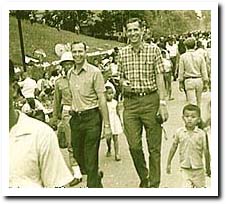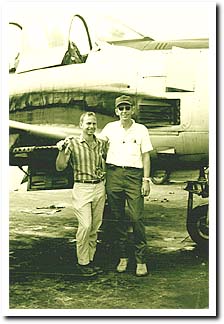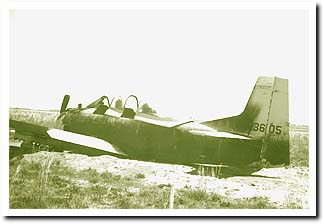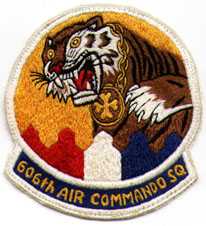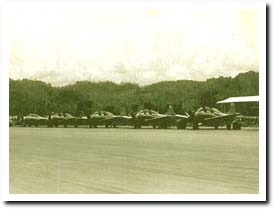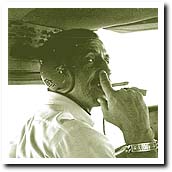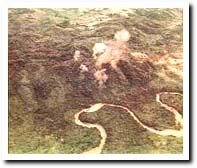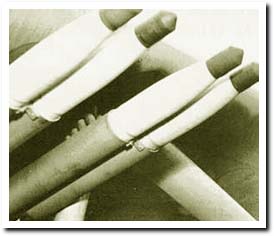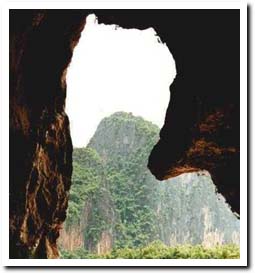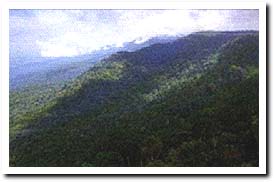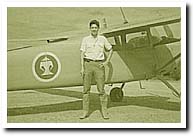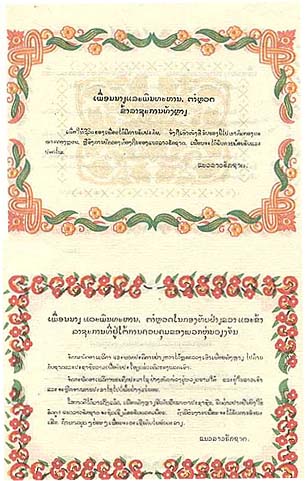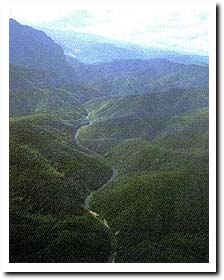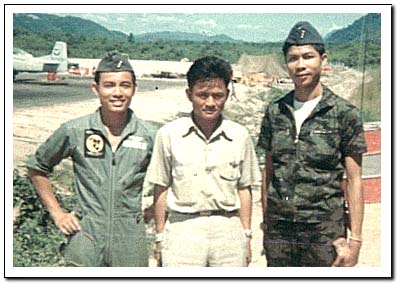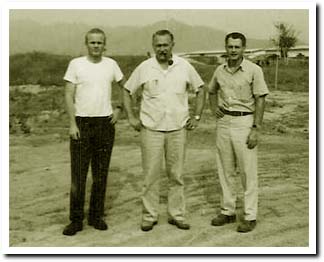"I learned to watch, to put my trust in other hands than mine. I learned to wander. I learned what every dreaming child needs to know -- that no horizon is so far that you cannot get above it or beyond it. These I learned at once. But most things come harder." - Beryl Markham
My assignment to the 606th would prove to be the most exciting and dangerous year of my life and Hurlburt would be the beginning of this great adventure. To begin my story, its important to relate a couple of incidents that occurred during training that were pretty rough on me and the other pilots in my class. Unfortunately I was involved in both of them, two aircraft accidents in two days. Both incidents occurred towards the end of my training, In the first instance, I blew an engine and threw a piston through the cowling knocking off the intake manifold just as I pulled off a dive bomb pass on Range 73. The aircraft caught fire from all of the fuel and oil streaming back down the left side just below the canopy. I had myself a glider and I was too low to bail out. Luckily I was in position to dead stick the burning airplane wheels up on one of the run-in lines on Range 70. As I set up the airspeed for the forced landing, I kept reminding myself don�t stretch the glide. It surprised me how fast things were happening. In my mind, I went over the procedure for a belly landing: blow back the canopy, shut off the fuel, and drop full flaps. It occurred to me that blowing the canopy before the fuel was shut off would put the flames in my lap. The last thing I did as I flared the airplane was blow the canopy.
The very next day, Denny Anderson and Buddy Blake were not so lucky. They pulled the wings off of their T-28 after a pass dropping inert 500-LB bombs on the Tactical Range West of Hurlburt. It gave me a horrible sensation watching the airplane disintegrate and not being able to do anything about it. The aircraft impacted almost immediately after it came apart. There were no chutes. Being involved in this accident had a chilling effect on me. You see Anderson was my instructor and I was taken off the schedule and Buddy filled in for me because of my accident the previous day. I was not expected to fly this day, but at briefing there was an open rear cockpit so I asked at the very last minute to let me fly in the T-28 with the empty seat. Otherwise, if I had stayed on the original schedule I would have been with Denny. Maybe it just wasn�t my time to go and someone was looking out for me.
The day came for the deployment of the 606th and the C-141s arrived and took the unit onboard and off we went over Alaska, to Japan, to Taiwan, and finally Thailand. After riding for 16 hours in those red nylon strap seats, we arrived at Udorn only to be immediately placed on some C-130s that had been waiting for us and then it was off to NKP. Jack Drummond, who later joined us in the 606th, happened to be the AC on the bird I was assigned to ride to NKP. Later, Jack would became an excellent fighter pilot and earn high praise for his night work over the trail as a Zorro. We were finally going to arrive at NKP where we all looked forward to stretching our legs and getting some much-needed sleep. The first view I had of my new base was out the front window of the Herc where I saw a short PSP runway that shook and rattled when the wheels came into contact with the metal planking. This old runway couldn�t have been over 5,000 ft long and was probably about 75 ft wide. It also was slicker than you know what when it was wet, but it would have to do until the new concrete runway was finished. It would be awhile before I could try out the PSP runway, as I was about to make another change. We had arrived several weeks ahead of our T-28s because the aircraft had to be assembled and checked out in Bangkok before they could be flown up to NKP. There was nothing for the T-28 pilots to do without airplanes so we were asked to go to Udorn and help instruct the Thai and Lao students in training at Waterpump. It was at Udorn in June or early July that I crossed paths with Bob again. It seems that Bob was flying from Savanahket to Udorn when the U-17 he was piloting suddenly lost power because the throttle linkage had become disconnected. This created an immediate problem for Bob in more ways than one. This very interesting story requires more time and details that only Bob, Al Shinkle, or Doc Nichols can provide, so I will proceed to narrate other vignettes of our association with each other. Unknown to me at this time Bob would soon be going to Luang Prabang. Luang Prabang
Seeing this as an opportunity to become part of the Air War in Laos, I eagerly accepted. I went through the process in Vientiane of removing all of my contact and identity with the U.S. Air Force, put on my civilian clothes, and took a flight on Air America to LP. Upon arrival, I was unceremoniously deposited upon the ramp with my meager baggage not knowing anyone or where to go. I then noticed the AOC building at one end of the runway with 12 T-28s parked in front.
I wandered up to the AOC where the occupants viewed me as something that had been misplaced. I tried to explain that I was there from AIRA to help them. Without comment General Ma rose up and headed for the door with his pilots close behind. He soon marshaled his force on the runway and 12 T-28s departed LP and flew off to the North. Not knowing where to go, I took a seat on the steps and waited. Approximately 30 minutes later, the aircraft returned. I jumped up anxiously to hear reports on their mission. The pilots deplaned, jumped on their motorcycles and went off to town for lunch. A short time later they returned and without a word went into the AOC for a nap. In the middle of the afternoon an Army jeep pulled up and a young Lt with maps under his arm went inside and immediately General Ma, Capt. Prayounh, and Capt. Khampanh huddled around the map. Something was said and they all went to the airplanes and off they flew again. Again after a short flight they returned and jumped on their motorcycles and went off to town calling it a day. The USAID Director, John Perry, drove up and offered to drive me to where the team was staying, which was in the USAID guest quarters. I thought, getting involved in this war was not going to be easy. At the end of my first day at LP, I felt like a complete failure. I had arrived and other than Mr Perry and the three Americans that were my team, no one had said a word to me. This was the pattern for the next several days, a flight in the morning and one in the afternoon. I was beginning to think this was not going to be a fun assignment and this was only July; things just had to get better. Then one day I looked up and saw this U-17 come taxiing up to the AOC and Bob Downs hopped out of the aircraft with a Swedish �K� sub machine gun over his shoulder and his trademark grin from ear-to-ear. I was sure glad to see him. It was like he had heard my prayers and he showed up just like a guardian angel. I soon learned that Bob was very familiar with LP and what General Ma was doing. Bob and Al Shinkle had been coming to LP from time to time to help General Ma as they had helped him in Savanahket. This included finding targets by flying visual recce in the area around Nam Bac and up the Nam Ou River. Bob was very helpful to me as he explained to General Ma that I was a good guy and was there to help them. This seemed to break the code and my relationship with General Ma and the pilots improved from that day on. One day soon after his arrival, Bob came back from one of his visual recce missions up the Nam Ou all excited. It seems he was flying right down on top of the water between the mountains that provided the shoreline on each side of the river. He rounded a bend and at a place where the Nam Bac River flowed into the Nam Ou, caught a sizable force in the open and drew considerable ground fire from the area. In the future, this was where we could always count on encountering troops and ground fire. The bad guys got lucky and Bob had holes in his wing. This really upset him, he briefed the Lao pilots on where he had been and soon a flight was on the way to see if they could catch the bad guys still in the open. The pilots returned in a jubilant mood claiming many KIA and several boats destroyed. My Local Area Checkout
Bob confessed that he and Al Shinkle had been checking out this area a few weeks back and wasn�t sure the people on some of these hilltops were bad guys as they were always waving as the U-17 passed overhead. General Ma later informed Bob that the guys were not waving at him but to the gun crews on the next hill that were always shooting at us. They were yelling to shoot this airplane. We were always the last to know. At least the bad guys benefited from a great airshow. As our flight progressed up the Nam Ou with not much happening, Bob made a sudden departure from the normal route and took up a northeasterly heading. I asked him what was going on. He replied that he had been up this way with Shinkle and had seen something on one of the hilltops and he wanted to check it out. He put the U-17 down into the treetops and began flying the nape of the earth up and around the hilltops, the scenery was incredible. He really had the old U-17 on the red line and being so close to the ground it gave us the sensation of going fast. As we rounded a hill, Bob popped the airplane up and over the hilltop rolled it over and pulled hard down the other side. I look out the window and I�m looking point blank into one of several active 12.7mm gun positions not ten feet away from my side of the airplane. The bad guys were blasting away with the guns while some others were running for cover.
Here we had only been flying together for one day and almost found the golden BB. I soon realized that my life would never be the same as long as I associated with Bob. This became truer with each mission we flew together. Like a cat with nine lives, I didn�t know how many I had used up. The Day the Engine Died Bob had been at LP for several weeks and we had flown a lot of missions together in support of the FAR troops in MR-I. In the meantime, Bob had checked me out in the U-17 and on this day I was in the left seat and we set off for Nam Bac to FAC a target that was briefed for the T-28s. Our armament guy wanted to ride along so we said sure get in. The FAR had launched an operation to recapture Nam Bac at the end of the last rainy season and had succeeded beyond their best expectations. Now the bad guys were moving back into the region and were starting to counter attack. This put a lot of pressure on the forces holding Nam Bac. We flew up the Nam Ou and turned to the west at the Nam Bac River junction opposite Muong Ngoi. This is the area that I mentioned earlier that had gotten so much of our attention. We were cruising along alternating altitudes between 500 and 1,500 ft looking for the target, when all at once the valley floor erupted in fire and smoke and craters opened up right below the aircraft. The explosions tossed the U-17 around and the jolts were prominently felt in the cockpit. After several wild gyrations to get out of the valley, we looked up and saw that we were right in the middle of the T-28 airstrike. The aircraft had arrived early and decided to bomb without our help.
The little guys had almost hit us while attacking the briefed target. We wanted no more of this type of action, so we retreated back down the valley to regroup. Our armament guy was shook-up and wanted to know if we did this kind of thing very often. Bob told him that once at Savanahket he had been so low during the airstrike that he had seen the bad guys run out of a bomb crater after the bomb exploded. They dusted themselves off and started firing their guns again. So much for all the high body counts that one heard about in SVN. Since the airstrike went off without us, we still had rockets left and instead of firing them off at maximum range up-country. It was decided that we would fire them into a big cave we had seen in one of the mountains at the junction of the two rivers. We had been told by the FAR that thus was the HQ for the bad guys in MR-I.
The cave was located in the face of the mountain on the West Side of the river. We now flew around trying to determine the best way to get into position to fire the rockets. For the best chance to hit the cave, we needed to come in from Muong Ngoi; then bank around the mountain that was on the east side of the river, line up the cave in a descending left turn, fire the rockets, and continue left into a climbing turn heading South down the river. Even though the target was at a high angle off, I thought we could hit it. Sounds easy doesn�t it? I carefully set up the attack and started the descending left turn. Bob laughingly said, �I bet you five bucks you miss�. I lined up the mouth of the cave with my grease pencil mark on the windscreen and fired all four rockets into the cave and started my break to the South. Then it happened. The damn engine sputtered twice and then quit. We had just blasted the hell out of the bad guys and we were going to wind up in the river in the worst possible place we could be. At this point, I didn�t even care that they were shooting at us. Bob very calmly told me don�t stall it but get all the altitude you can. He immediately went to work trying to restart the engine. We finally got it to run with the boost pump on and the fuel mixture leaned way down. Bob said to keep it climbing towards LP. I looked back at the Armament guy. He was pale, eyes as big as saucers and was very quiet. In fact there was not much conversation from any of us. After what seemed like an eternity, the runway at LP came into view. We came over the field at 12,000 ft and spiraled down to a landing. We wanted to make sure that if the engine quit, we could still make it to the runway. We took the fuel filter off of the aircraft and it was completely clogged. No one was ever able to explain how Bob was able to get the engine running. Me I don�t care it worked when we needed it. The armament guy gave up flying. Wonder why. Me I just chalked it up to the little black cloud that was beginning to follow us around. One change did occur as a result of the incident; fuel was strained through a chamois after this. When the airplane was checked, we found there was one bullet hole in the elevator and neither one of us had heard or felt anything so we don�t know if it even happened on this flight. The cave was still there and tempting every time we went up the Nam Ou. It was still there in 69-70 on my second tour and the Ravens put in a lot airstrikes on it. Only Bob and I had figured out the proper way to attack it but we had lost all our enthusiasm for pursuing it further. Our luck was holding, here we were flying in very hostile country without survival gear or radios and we almost get knocked out of the air twice in the same day. Wonder if anyone would have ever found us. You know I never did collect that five bucks Bob bet me on hitting that cave. The Night the Lights Went Out
The more Bob and I flew together it seemed like the more chances we were willing to take. There was the time that we had been down to Vientiane for a meeting of AOC Commanders and we stayed much later than we had planned. By the time we left for the airport we knew that we would have to land after dark. LP was not equipped with runway lights. So before leaving we called our guys on the radio and told them when we arrived to park the jeeps at each end of the runway with the lights on. This is a technique that would prove invaluable in 1969 when we had to recover Mike Cavenaugh and several other Ravens from Lima Site 20A. They had been at Moung Soui when it fell to the bad guys and couldn�t get back to Alternate. The FACs were low on gas and had to recover at LP after dark. I now had some friends for life. On the way to the airport, we realized that we didn�t have a flashlight and the instrument lights on the U-17 were inoperative. Bob had a sure fire remedy. We would stop in town and buy a flashlight. Good idea but we couldn�t find a store that had any semblance of a flashlight. It was right at this moment that we should have realized that our black cloud was still with us and surrendered to common sense. But not these gallant warriors. We would improvise with our commando know how, after all we were airshow qualified. The answer lay in candles. We would buy candles. I would hold it and Bob would fly. The storekeeper told us to buy extra candles as they burned very quick. He was right too. You have to visualize what is about to happen. We were going to takeoff in the dark with no lights and fly over some of the most forbidding terrain in the world. The karst and mountains in this area went up to 8,000 ft. and many were not on the map. We would be in and out of the clouds and have to use time and distance to navigate as there were no nav aids at LP. All of this in an airplane whose engine had been known to quit suddenly without warning. Sound ominous doesn�t it.
Dead End Kids This vignette I saved for last as it shows how complacent you can get when flying with someone you trust. Bob and I had been flying together regularly for several months. We had flown FAC missions, Strike missions, Armed Recce missions, and Psy Ops missions. It was the Pys Ops missions that almost proved our undoing. It proved to me to be careful about what you are thinking as the wrong words can come out at the wrong time.
With all the drag caused by the leaflets on the tail wheel, the U-17 climbed and climbed, but it couldn�t get out of the ground fire. Gunfire was so rapid that it was like being inside a popcorn popper. While telling me this very interesting story, Bob kept repeating �Dumb�-�Dumb�- �Dumb� - - why do these things always seem to happen to me. Apparently this time the Psy Ops guy was right for the village was full of bad guys, but you could tell by their response to the leaflet drop that they didn�t want to surrender. Convinced that we could never make this same mistake twice, we took off, climbed to 1,500 ft and proceeded up the Nam Khang River. When we approached the first target village and began our let down to 500 feet. This would set us up for the drop. A sudden noise got our attention. Our little guy clicked his zippo lighter shut after lighting his cigarette. It sounded just like a round striking the aircraft. We gave him a dirty look but he didn�t have a clue about what he had done. He just kept smiling. He was in the back seat with the leaflets and he would throw them out through the rear side windows on our signal. We continued up the river, I had the map with the villages marked on it in my lap, and all was going well until we reached a �Y� in the river.
Now the situation was deteriorating rapidly and Bob was pulling the airplane up into wifferdills along with the �Ss�. Bob was already looking for a bamboo break or a treetop to set the airplane down on. We were now down to lowering the flaps during the reversals to give us more lift and help tighten up the turns. I sensed that Bob was about to call out for a crash landing when he suddenly reached down deep inside himself and got the maximum turn from the airplane by pulling it up, dropping full flaps and headed down to the valley floor. We actually dragged the landing gear through the treetops and made it by inches. This was the greatest feat of airmanship that I have ever witnessed. This was a maneuver that I would use myself to get away from the 57mm guns in the Beng Valley in 1969. We laughed about it afterwards but we both knew that we had been very lucky. I will always be grateful because Bob bailed me out of a bad decision, and the little guy doesn�t realize how lucky he was because if I could have got him through the door he would have been gone. Like firing rockets into caves, we also lost our enthusiasm for dropping leaflets as the little black cloud still seemed to be following us, and besides it was time for Bob to rotate back to the states as his TDY was at an end. Postscripts Bob left soon after the blind valley incident and things were never quite the same for me. He left me the Swedish �K� but took the U-17 back down South to Savanahket. I had to find other means to provide the air support for MR-I. Mostly, I used Air America and Continental Porters, which weren�t free, and occasionally the T-28. We were restricted by AIRA as to when we could fly the T-28. Officially the Embassy was on record as saying it supported the provisions of the Geneva Accords and had proclaimed that there were no combat troops in Laos, and the Ambassador had testified before Congress that officially only the Lao pilots were flying the T-28s. Unofficially, the Americans only flew maintenance test hops on the T-28. Sometimes those test hops had strange configurations. My relationship with General Ma was improving daily. I admired him a lot, especially his focus, nationalistic spirit and friendly personality. I also believe that he was well liked by his men and had their unquestioned loyalty. I know that he was admired by the Air Commandos and by those of us who were covertly assigned to help the RLAF. Lately, I had been observing Ma closely and it was easy to see that he was not in good health. It was in late August or early September 1966 that Col Pettigrew gave me permission to take him to the hospital at Korat AFB for a checkup. He climbed into the rear seat of the T-28 and away we went. Col P had cleared it for us to fly into the airbase but arriving without a flight plan created a little confusion at Korat. Security Police and the Wing Commander were there to meet us when we cleared the active runway. The Base had been advised that we were coming, but the Wing CO had to see for himself. Here was an American in civilian clothes flying a T-28 with Laotian Air Force markings and a Laotian Brigadier General in the rear cockpit. Once we had established who we were, I handed over my Browning and gun belt to the SPs for safekeeping, and the Wing CO took us to the hospital. I explained to the medical staff the best I could of why we were there. The Flight Surgeon took General Ma and gave him as thorough a physical as they could, with x-rays, blood work and all. When the Lab results were back, the Doctors sat down and explained why General Ma had been feeling so bad. Outside of having the usual Lao maladies, he had chronic malaria and intestinal parasites. Also, he was tired and worn out from years of continuous combat. The docs packaged the results for me to take back to Vientiane. General Ma�s ailments would have to wait for awhile as other significant events were taking center stage. It appears that over the years General Ma�s actions had made more than a few enemies among the elite. Ma was an awesomely powerful leader who had experienced a lot of previous Government trickery so that now he firmly demanded absolute unwavering loyalty from his troops. To break his power, the General Staff felt it imperative to remove him as Commander of the RLAF and move him out of Savanahket. General Ma felt very strong about protecting and maintaining Laotian independence and defending Laos from enemies both inside and outside the country. He had taken a hard stand on how Vientiane was using the RLAF C-47s. He believed the C-47s to be involved in smuggling gold and other things of questionable legality (Opium). To protect their enterprises, the Army General Staff had seen it necessary to take the C-47s away from him and give them to General Sourith. This move split the RLAF into two factions as General Ma was made commander of only the T-28 Forces and sent to Luang Prabang. He later found out that the General Staff was making plans to also take the T-28s away from him. The plan also called for him to move to Vientiane as chief of the Combined Operations Center. This proved to be too much for General Ma and was a major factor that led him to the course of action that he was soon to take. COUP de ETAT Before anything could be done to help General Ma with his medical problems, he suddenly left LP without warning and took his band of warriors to Moung Soui from where he launched his abortive coup in late September 1966. The day he left, I knew that something was wrong when I rounded the corner of the AOC and saw General Ma, Capt. Prayounh, and Capt. Khampanh huddled around a map. As soon as they saw me, they immediately stopped what they were doing and dispersed.
Early the next morning, the T-28s took off from Savanahket and bombed targets around Watttay Airport, the Army Barracks, and Chinamo HQ North of Vientiane. Later that day, the Coup fell apart. Ma and the T-28 pilots fled across the river and landed at Udorn. The Thai Government impounded the aircraft and incarcerated General Ma and the pilots. They were later given political asylum. The General Staff executed Ma after he was captured following another failed Coup attempt in 1973. New Beginnings After General Ma left, we had to start all over. This included new crews and replacement aircraft. In addition, we had to operate with a great deal of hostility and suspicion from the Lao military of everything that we did involving the T-28s. Out of necessity, I had to start flying the T-28 on more test hops. My involvement helped to ease the concerns of the senior Lao military at LP. Somehow FAR leadership felt that if I was involved it made everything okay and they could trust the T-28 pilots.
At first they didn�t want the aircraft to carry bombs, but I convinced them that the airplanes capability was being wasted. The Lao Army slowly changed their minds about what ordnance we could carry. For the first time, I felt I was capable of conducting air operations in MR-I without General Ma or Bob and the benefit of the little gray U-17. The bad news was, we only had six T-28s to cover all of MR-I. There were some FAR requirements that we couldn�t meet. It would be at least six weeks before the strength of the Squadron was even close to being at full strength. This became a totally different time for me at LP. I didn�t realize how dependent I had become on having Bob and the U-17. He was a great pilot and one of the few great combat leaders that I have known. The courage and bravery he displayed is worthy of comment. When together, we were so crazy that it is hard to say what we deserved, a combat decoration in recognition of our accomplishments and bravery or a court-martial for some of the wild things we did. We were to get neither, because no one knew and there was no one there to write it up. Besides we were not in it for the medals. In the next three months, I would lose all of the T-28s again. This time the NVA sent commandos on a night attack against the airfield and the AOC. The bad guys came in after midnight and blew up the T-28s, the Bomb Dump, and attacked the AIRA compound and living quarters of the T-28 squadron personnel. A few weeks following the attack on LP, I would be med-evaced to the hospital in Tachikawa, Japan where I would have to spend two months recovering from injuries and ailments I received as the result of an incident up country. I was involved in my second wheels up landing in less than a year. These are stories that I will elaborate on in more detail in future vignettes about LP. There is a lot of truth in the old saying, �Ignorance is bliss.� Sometimes I think that we were too crazy to be scared, but I know there were many times that I had the adrenaline rush and the hair stand up on the back of my neck. I�ve never been a good teller of war stories; I have generally left that to others. The experiences I had in Laos have been shared with very few people. I believe that now is a good time to remember the great adventures that we experienced. I decided to write these vignettes while I was still young enough to recall them. Bob and I have kidded each other for many years about all the times we tried to kill each other, but we have never gone public with some of the wild things we did. For years I have been asked to provide data for authors writing books about the war in Laos and I have declined to do so. It was never clear on just how much or what information we could discuss. Besides you never know the true agenda of the author or how the information will be used. The Air Commandos that I most admire have a propensity for being closed-mouth about the classified projects that they have been involved in. Many of us have lived that code of silence. |

